|
|
|
Sort Order |
|
|
|
Items / Page
|
|
|
|
|
|
|
| Srl | Item |
| 1 |
ID:
190101
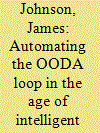

|
|
|
|
|
| Summary/Abstract |
This article argues that artificial intelligence (AI) enabled capabilities cannot effectively or reliably compliment (let alone replace) the role of humans in understanding and apprehending the strategic environment to make predictions and judgments that inform strategic decisions. Furthermore, the rapid diffusion of and growing dependency on AI technology at all levels of warfare will have strategic consequences that counterintuitively increase the importance of human involvement in these tasks. Therefore, restricting the use of AI technology to automate decision-making tasks at a tactical level will do little to contain or control the effects of this synthesis at a strategic level of warfare. The article re-visits John Boyd’s observation-orientation-decision-action metaphorical decision-making cycle (or “OODA loop”) to advance an epistemological critique of AI-enabled capabilities (especially machine learning approaches) to augment command-and-control decision-making processes. In particular, the article draws insights from Boyd’s emphasis on “orientation” as a schema to elucidate the role of human cognition (perception, emotion, and heuristics) in defense planning in a non-linear world characterized by complexity, novelty, and uncertainty. It also engages with the Clausewitzian notion of “military genius” – and its role in “mission command” – human cognition, systems, and evolution theory to consider the strategic implications of automating the OODA loop.
|
|
|
|
|
|
|
|
|
|
|
|
|
|
|
|
| 2 |
ID:
152298
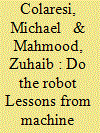

|
|
|
|
|
| Summary/Abstract |
Increasingly, scholars interested in understanding conflict processes have turned to evaluating out-of-sample forecasts to judge and compare the usefulness of their models. Research in this vein has made significant progress in identifying and avoiding the problem of overfitting sample data. Yet there has been less research providing strategies and tools to practically improve the out-of-sample performance of existing models and connect forecasting improvement to the goal of theory development in conflict studies. In this article, we fill this void by building on lessons from machine learning research. We highlight a set of iterative tasks, which David Blei terms ‘Box’s loop’, that can be summarized as build, compute, critique, and think. While the initial steps of Box’s loop will be familiar to researchers, the underutilized process of model criticism allows researchers to iteratively learn more useful representations of the data generation process from the discrepancies between the trained model and held-out data. To benefit from iterative model criticism, we advise researchers not only to split their available data into separate training and test sets, but also sample from their training data to allow for iterative model development, as is common in machine learning applications. Since practical tools for model criticism in particular are underdeveloped, we also provide software for new visualizations that build upon already existing tools. We use models of civil war onset to provide an illustration of how our machine learning-inspired research design can simultaneously improve out-of-sample forecasting performance and identify useful theoretical contributions. We believe these research strategies can complement existing designs to accelerate innovations across conflict processes.
|
|
|
|
|
|
|
|
|
|
|
|
|
|
|
|
| 3 |
ID:
162890


|
|
|
|
|
| Summary/Abstract |
This article discusses a new method for the sizing of operating reserves by electric power system operators. Operating reserves are used by system operators to deal with unexpected variations of demand and generation, and maintain a secure operation of the system. This becomes increasingly challenging due to the increasing share of renewable generation based on variable resources. This paper revisits the current sizing method applied in Belgium, which is based on a static approach that determines the required capacity once a year. The presented dynamic sizing method determines the required capacity on a daily basis, using the estimated probability of facing a system imbalance during the next day. This risk is estimated based on historical observations of system conditions by means of machine learning algorithms. A proof of concept is presented for the Belgian system, and demonstrates that the proposed methodology improves reliability management while decreasing the average capacity to be contracted. The method is compliant with European market design, and the corresponding regulatory framework, and is of particular interest for systems with a high share of renewable generation. For these reasons a gradual implementation in Belgium towards 2020 has been decided based on the results of this study.
|
|
|
|
|
|
|
|
|
|
|
|
|
|
|
|
| 4 |
ID:
192749
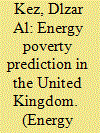

|
|
|
|
|
| Summary/Abstract |
Energy poverty affects billions worldwide, including people in developed and developing countries. Identifying those living in energy poverty and implementing successful solutions require timely and detailed survey data, which can be costly, time-consuming, and difficult to obtain, particularly in rural areas. Through machine learning, this study investigates the possibility of identifying vulnerable households by combining satellite remote sensing with socioeconomic survey data in the UK. In doing so, this research develops a machine learning-based approach to predicting energy poverty in the UK using the low income low energy efficiency (LILEE) indicator derived from a combination of remote sensing and socioeconomic data. Data on energy consumption, building characteristics, household income, and other relevant variables at the local authority level are fused with geospatial satellite imagery. The findings indicate that a machine learning algorithm incorporating geographical and environmental information can predict approximately 83% of districts with significant energy poverty. This study contributes to the expanding body of research on energy poverty prediction and can help shape policy and decision-making for energy efficiency and social fairness in the UK and worldwide.
|
|
|
|
|
|
|
|
|
|
|
|
|
|
|
|
| 5 |
ID:
175342
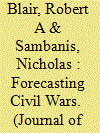

|
|
|
|
|
| Summary/Abstract |
Does theory contribute to forecasting accuracy? We use event data to show that a parsimonious model grounded in prominent theories of conflict escalation can forecast civil war onset with high accuracy and over shorter temporal windows than has generally been possible. Our forecasting model draws on “procedural” variables, building on insights from the contentious politics literature. We show that a procedural model outperforms more inductive, atheoretical alternatives and also outperforms models based on countries’ structural characteristics, which previously dominated models of civil war onset. We find that process can substitute for structure over short forecasting windows. We also find a more direct connection between theory and forecasting than is sometimes assumed, though we suggest that future researchers treat the value-added of theory for prediction not as an assumption but rather as a hypothesis to test.
|
|
|
|
|
|
|
|
|
|
|
|
|
|
|
|
| 6 |
ID:
187819
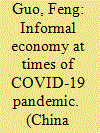

|
|
|
|
|
| Summary/Abstract |
We provide a first view of vulnerable informal economy after the blows from COVID-19, using transaction-level business data of around 80 million offline micro businesses (OMBs) owners from the largest Fintech company in China and employing machine learning method for causal inference. We find that the OMBs activities in China experienced an immediate and dramatic drop of 50% during the trough. The businesses had rebounded to around 80% of where they should be seven weeks after the COVID-19 outbreak, but had remained at this level until the end of our time window. We find a larger disruption to the OMBs in urban areas, the female merchants and the merchants who were not grown up in the places where they conducted businesses. We discuss the implications for policy support to the most vulnerable, and highlight the importance to take full advantage of digital development to follow up the informal economy.
|
|
|
|
|
|
|
|
|
|
|
|
|
|
|
|
| 7 |
ID:
166943
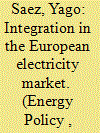

|
|
|
|
|
| Summary/Abstract |
The European electricity market is immersed in an integration process that requires a fundamental transformation. In this process, Flow-Based Market Coupling, which was employed for the first time in the Central Western Europe electricity market in 2015 as a means to manage cross-border capacity allocation, is a crucial cornerstone. The novelty of this paper lies in the analysis of the price convergence or congestion across the Central Western Europe region since the Flow-Based Market Coupling was implemented. We propose using random forests to build learning models that are trained and tested with features from connected markets of this region during 2016 and 2017. These machine learning models are used for mining knowledge about our target variable, price equalization. To search for robust predictive patterns that decision-makers can use to understand congestion situations, we have tested different combinations of learning schemes, several estimators and different model parameters. The results of all implemented models are robust and reveal that promoting renewable energy can contradict the integration of the electricity market if the grid network and, in particular, the transmission lines are not adapted to the new paradigm.
|
|
|
|
|
|
|
|
|
|
|
|
|
|
|
|
| 8 |
ID:
180674
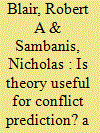

|
|
|
|
|
| Summary/Abstract |
Beger, Morgan, and Ward (BM&W) call into question the results of our article on forecasting civil wars. They claim that our theoretically-informed model of conflict escalation under-performs more mechanical, inductive alternatives. This claim is false. BM&W’s critiques are misguided or inconsequential, and their conclusions hinge on a minor technical question regarding receiver operating characteristic (ROC) curves: should the curves be smoothed, or should empirical curves be used? BM&W assert that empirical curves should be used and all of their conclusions depend on this subjective modeling choice. We extend our original analysis to show that our theoretically-informed model performs as well as or better than more atheoretical alternatives across a range of performance metrics and robustness specifications. As in our original article, we conclude by encouraging conflict forecasters to treat the value added of theory not as an assumption, but rather as a hypothesis to test.
|
|
|
|
|
|
|
|
|
|
|
|
|
|
|
|
| 9 |
ID:
172208
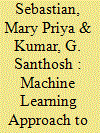

|
|
|
|
|
| Summary/Abstract |
This article explores in depth various sandhi (joining) rules in Kerala’s Malayalam language, which play a vital role in framing of the inflected and agglutinated forms of words and their compounds. It discusses significant progress in a scientific method to generate a specific annotated data set of Malayalam words that would be useful in many Natural Language Processing tasks which involve Malayalam preprocessing. The article discusses the results and issues encountered in developing this word-splitting tool for Malayalam, mainly in the context of improving the alignments between parallel texts that form a core resource in the Machine Translation task.
|
|
|
|
|
|
|
|
|
|
|
|
|
|
|
|
| 10 |
ID:
193296
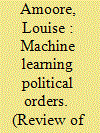

|
|
|
|
|
| Summary/Abstract |
A significant set of epistemic and political transformations are taking place as states and societies begin to understand themselves and their problems through the paradigm of deep neural network algorithms. A machine learning political order does not merely change the political technologies of governance, but is itself a reordering of politics, of what the political can be. When algorithmic systems reduce the pluridimensionality of politics to the output of a model, they simultaneously foreclose the potential for other political claims to be made and alternative political projects to be built. More than this foreclosure, a machine learning political order actively profits and learns from the fracturing of communities and the destabilising of democratic rights. The transformation from rules-based algorithms to deep learning models has paralleled the undoing of rules-based social and international orders – from the use of machine learning in the campaigns of the UK EU referendum, to the trialling of algorithmic immigration and welfare systems, and the use of deep learning in the COVID-19 pandemic – with political problems becoming reconfigured as machine learning problems. Machine learning political orders decouple their attributes, features and clusters from underlying social values, no longer tethered to notions of good governance or a good society, but searching instead for the optimal function of abstract representations of data.
|
|
|
|
|
|
|
|
|
|
|
|
|
|
|
|
| 11 |
ID:
183698
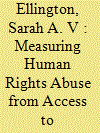

|
|
|
|
|
| Summary/Abstract |
Existing measures of human rights abuses are often only available at the country-year level. Several more fine-grained measures exhibit spatio-temporal inaccuracies or reporting biases due to the primary sources upon which they rely. To address these challenges, and to increase the diversity of available human rights measures more generally, this study provides the first quantitative effort to measure human rights abuses from textual records of citizen-government interactions. Using a dataset encompassing over 1.5 million access-to-information (ATI) requests made to the Mexican federal government from June 2003 onward, supervised classification is used to identify the subset of these requests that pertain to human rights abuses of various types. The results from this supervised machine learning exercise are validated against (i) gold standard ATI requests pertaining to past human rights abuses in Mexico and (ii) several accepted external measures of sub-national and sub-annual human rights abuses. In doing so, we demonstrate that the measurement of human rights abuses from citizen-submitted ATI request texts can provide measures of human rights abuse that exhibit both high validity and notable spatio-temporal specificity, relative to existent human rights datasets and variables.
|
|
|
|
|
|
|
|
|
|
|
|
|
|
|
|
| 12 |
ID:
192230
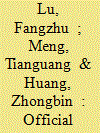

|
|
|
|
|
| Summary/Abstract |
Social media is the most popular platform for the expression of public opinion, and it is a critical channel through which researchers can observe the dynamics and patterns of public opinion. This study explores the political origins of Chinese nationalism by focusing on how official media shapes mass nationalism in Cyber China. Analyzing 26 million Weibo posts made during the coronavirus (COVID-19) pandemic, we found significant variations in nationalism among user types, localities, and stages of the pandemic. Unlike previous studies, we found that the official Chinese media did not always play the expected role of promoting nationalism; instead, it acted as a system of emotional valves that channeled social sentiment. Official media is intended to stabilize social sentiment and prevent social unrest, and nationalistic news stories are used to draw attention away from domestic problems.
|
|
|
|
|
|
|
|
|
|
|
|
|
|
|
|
| 13 |
ID:
152304
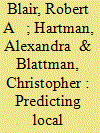

|
|
|
|
|
| Summary/Abstract |
Riots, murders, lynchings, and other forms of local violence are costly to security forces and society at large. Identifying risk factors and forecasting where local violence is most likely to occur should help allocate scarce peacekeeping and policing resources. Most forecasting exercises of this kind rely on structural or event data, but these have many limitations in the poorest and most war-torn states, where the need for prediction is arguably most urgent. We adopt an alternative approach, applying machine learning techniques to original panel survey data from Liberia to predict collective, interpersonal, and extrajudicial violence two years into the future. We first train our models to predict 2010 local violence using 2008 risk factors, then generate forecasts for 2012 before collecting new data. Our models achieve out-of-sample AUCs ranging from 0.65 to 0.74, depending on our specification of the dependent variable. The models also draw our attention to risk factors different from those typically emphasized in studies aimed at causal inference alone. For example, we find that while ethnic heterogeneity and polarization are reliable predictors of local violence, adverse economic shocks are not. Surprisingly, we also find that the risk of local violence is higher rather than lower in communities where minority and majority ethnic groups share power. These counter-intuitive results illustrate the usefulness of prediction for generating new stylized facts for future research to explain. Ours is one of just two attempts to forecast local violence using survey data, and we conclude by discussing how our approach can be replicated and extended as similar datasets proliferate.
|
|
|
|
|
|
|
|
|
|
|
|
|
|
|
|
| 14 |
ID:
148220
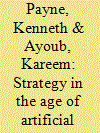

|
|
|
|
|
| Summary/Abstract |
We argue that Artificial Intelligence (AI) will, in the very near future, have a profound impact on the conduct of strategy and will be disruptive of existing power balances. To do so, we review the psychological foundations of strategy and explore the ways in which AI will impact human decision-making. We then review current and evolving capabilities in ‘narrow’, modular AI that is optimised to perform in a particular environment, and explore its military potential. Lastly, we look ahead to the more distant prospect of a general AI.
|
|
|
|
|
|
|
|
|
|
|
|
|
|
|
|
| 15 |
ID:
172219
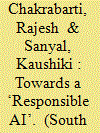

|
|
|
|
|
| Summary/Abstract |
The impact of artificial intelligence (AI) on every aspect of our lives is inevitable and already being felt in numerous ways. Countries are grappling with the opportunities and challenges that AI presents. Among the South Asian countries, India has taken a lead in promoting and regulating AI. However, it lags significantly behind countries such as China or the United States. This article explores India’s AI ecosystem, the threats and challenges it faces, and the ethical issues it needs to consider. Finally, it examines the common concerns among South Asian nations and the possibility of coming together to promote and regulate AI in the region.
|
|
|
|
|
|
|
|
|
|
|
|
|
|
|
|
| 16 |
ID:
188152
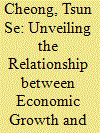

|
|
|
|
|
| Summary/Abstract |
This study investigates the relationship between economic growth and inequality by employing the artificial neural network approach. There are many important findings. First, this work reveals the underlying functional form of economic growth and inequality by using three-dimensional diagrams. Second, the findings show that there was an inverted-U relationship between economic growth and inequality. This explains apparent contradictions in research findings in the literature. Third, the optimal level of inequality, which corresponds to the highest level of economic growth, is computed for different economies. Our findings were confirmed by the development processes in many developing countries and also in China in recent years, thereby highlighting the importance of inequality alleviation in promoting further economic growth. These findings enable us to derive pragmatic policy implications for other developing countries at different stages of economic development in achieving sustainable growth with equity.
|
|
|
|
|
|
|
|
|
|
|
|
|
|
|
|
| 17 |
ID:
159929


|
|
|
|
|
| Summary/Abstract |
By 2020, the number of IOT devices will surpass 20.1 billion, and these devices combined with user interactions will generate enormous data streams that will challenge analytic capabilities constrained by human faculties, legal, regulatory, and policy frameworks designed for bygone eras. This work examines the impact of machine learning and artificial intelligence on legal, regulatory, policy and technical aspects of intelligence to provide insights into state, sub-state, and human behavior. This work develops an adaptive theory of Cyber Intelligence that will play an increasingly central role within the Intelligence Community in the decade(s) to come.
|
|
|
|
|
|
|
|
|
|
|
|
|
|
|
|
|
|
|
|
|